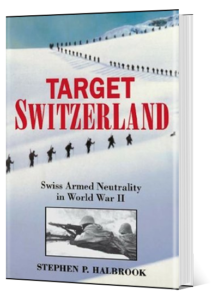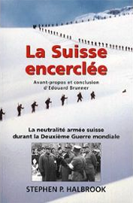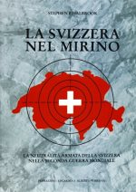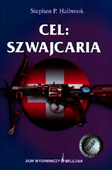
Target Switerland: Swiss Armed Neutrality in World War II
by Stephen P. Halbrook
Published by Da Capo Press (1998)
TRANSLATIONS
SUMMARY
In 1943, Adolf Hitler proclaimed that “all the rubbish of small nations existing in Europe must be liquidated,” even if it meant he would later “be attacked as ‘the butcher of the Swiss.’” In his diaries Josef Goebbels described Switzerland as “this stinking little state.” The Gestapo prepared lists of Swiss to be executed once the Nazis overran the country. Yet, as the Nazi tide spread across Europe from the Pyrenees to the Volga, one nation stood free, albeit armed to the teeth—its flag unbowed in a sea of twisted crosses.
This book examines German plans for the conquest of Switzerland, as well as Swiss preparations to resist the assault. After the fall of France the German Army was at the height of its power—but would “blitzkrieg” have worked in the Alps? On the other side stood General Guisan, with the best armed and trained citizens army in the world. Guisan planned to concede the lowlands and take his forces to the mountains—an “Alpine Redoubt” the Germans would later consider as unassailable.
Stephen P. Halbrook provides a brief military history of Switzerland, from the days when its pikemen ruled supreme on medieval battlefields, through the American Constitutional debates during which Swiss militia example was considered by the United States, to the 20th century, when Switzerland fielded Europe’s highest per capita of trained riflemen. European neutrality has never been a “gift” but a status, earned through armed deterrence. The little-known magnitude of Alpine fortifications is examined, as well as Swiss military doctrine, including its concept of instant mobilization, and the record of its air force in border skirmishes with the Luftwaffe. The Swiss have remained armed and free, ready to combat any aggressor, since 1291. When the ultimate cataclysm came to Europe in the 1940s, even the Nazis were deterred by the Swiss.
Beneath their benign “Heidi” image the Swiss have never trumpeted the fact of their military preparedness. The book will be an eye-opener to many Americans, who never imagined that the nation that retained its straight cross, not a twisted one, was a nation of shooters, fully prepared to turn the Alps into a deathtrap for the panzers, if the Germans had dared to attempt a conquest.
CONTENTS
- Prologue: Companions of the Oath
- From 1933 to the Eve of the War
- 1938: Anschluss of Switzerland?
- 1939: Hitler Launches World War II
- Spring 1940: All Fall But One
- Fall 1940: Target Switzerland
- 1941: The New Order
- 1942: “Oasis of Democracy”
- 1943: “A Pistol at Their Heads”
- 1944: War at the Border
- 1945: The Liberation of Europe
- Armed Neutrality to the 21st Century
NOTEWORTHY REVIEWS
“The recent focus on Swiss accommodations to the Third Reich has obscured the facts surrounding Switzerland’s success in deterring Nazi invasion, argues Halbrook in this narrative of Switzerland’s preparations for armed resistance during WWII. Concessions on commercial or refugee issues, Halbrook contends, were not enough by themselves to fend off one of history’s most ruthless dictatorships. What was decisive, he finds, was Swiss determination to defend itself by an armed force based on armed citizens. In contrast to Holland, Denmark or Norway, Switzerland during WWII successfully maintained its neutrality. It did so, argues Halbrook, by convincing Nazi Germany and its own citizens that any invader would pay in blood for every foot of ground, and in the end would find only devastation. Halbrook, a practicing attorney rather than an academic scholar, relies primarily on journalistic sources to make the points that Switzerland was prepared to abandon most of the country and fight to the last man from an Alpine redoubt. Among other questionable premises he accepts uncritically, he takes as given that militiamen armed primarily with bolt-action rifles and 50 rounds of ammunition constituted an effective fighting force in an age of mechanized war. His account, while written from a limited vantage point, nevertheless establishes a series of elements in danger of being submerged by the recent furor over bank accounts and trade figures.”
— PUBLISHER’S WEEKLY
Remarks made by Stephen Halbrook at the introduction of his book at the University Club, New York, New York, on July 16, 1998, and at the Mayflower Hotel, Washington, D.C., on July 21, 1998.
Americans have been known to confuse the Swiss flag—white cross, red background—with the Red Cross banner, which is the opposite. In World War II, Swiss fighter planes, painted with the Swiss flag, attempted to intercept all foreign planes in Swiss air space and to order them to land. An American pilot, asked whether he thought about firing on the fighters which instructed him to land, responded: “I would never fire on a Red Cross plane!”
Almost 1700 American pilots found refuge in Switzerland after their planes were damaged in bombing raids over Germany. However, the Nazis were not amused by Switzerland’s armed neutrality. Hitler was livid that the Swiss used fighters bought from Germany to shoot down 11 German Luftwaffe planes; the saboteurs he sent to blow up Swiss airfields were captured (they aroused suspicion because they were all dressed in the same odd outfits!).
It is a pleasure to have Sarpedon, a first-rate military publisher, fill the void in World War II history by publishing my book on the Nazi plans to eradicate the Swiss democracy and the Swiss plans to resist to the end. Over 200 years ago, America’s Founding Fathers like Patrick Henry and John Adams were inspired by the example of Switzerland—a democracy in a sea of monarchial despotism. Having devoted much of my career to American constitutional law, publishing books and arguing in the Supreme Court, I was intrigued to know how the Swiss institutions which influenced our Constitution proved their worthiness in the darkest years of European history: Hitler’s Third Reich, 1933-45.
In 1940, after the rest of central Europe collapsed before the German army, Swiss Commander in Chief Henri Guisan assembled his officers at the Rotli meadow near the Lake of Lucerne. He reminded them that, at this sacred spot, in the year 1291, the Swiss Confederation was born as an alliance against despotism. Guisan admonished that the Swiss would always stand up to any invader. One has only to recall the medieval battle of Morgarten, where 1400 Swiss peasants ambushed and defeated 20,000 Austrian knights.
In World War II, the Swiss had defenses no other country had. Let’s begin with the rifle in every home combined with the Alpine terrain. When the German Kaiser asked in 1912 what the quarter of a million Swiss militiamen would do if invaded by a half million German soldiers, a Swiss replied: shoot twice and go home. Switzerland also had a decentralized, direct democracy which could not be surrendered to a foreign enemy by a political elite. Some governments surrendered to Hitler without resistance based on the decision of a king or dictator; this was institutionally impossible in Switzerland. If an ordinary Swiss citizen was told that the Federal President—a relatively powerless official—had surrendered the country, the citizen might not even know the president’s name, and would have held any “surrender” order in contempt.
When Hitler came to power in 1933, the Swiss feared an invasion and began military preparations like no other European nation. On Hitler’s 1938 “Anchluss” or annexation of Austria, the Swiss Parliament declared that the Swiss were prepared to defend themselves “to the last drop of their blood.”
When the Fuehrer attacked Poland in 1939, General Guisan ordered the citizen army to resist any attack to the last cartridge. After Denmark and Norway fell in 1940, Guisan and the Federal Council gave the order to the populace: Aggressively attack invaders; act on your own initiative; regard any surrender broadcast or announcement as enemy propaganda; resist to the end. This was published as a message to the Swiss and a warning to the Germans; surrender was impossible, even if ordered by the government, for the prior order mandated that it be treated as an enemy lie.
When the Germany army, the Wehrmacht, attacked Belgium and Holland, it feigned preparations for attack through Switzerland. Like a giant movie set, divisions moved toward the Swiss border by day, only to sneak back again by night and repeat the ruse the next day. Both the Swiss and the French were tricked into thinking that concentrations of troops were massing to attack through Switzerland and into France. Swiss border troops nervously awaited an assault each time the clock approached the hour, for the Germans were punctual in lauching attacks on the hour.
When France collapsed, detailed Nazi invasion plans with names like “Case Switzerland” and “Operation Tannenbaum” were prepared for the German General Staff. They only awaited the Fuehrer’s nod.
Threatened with attack from German and Italian forces from all sides, General Guisan devised the strategy of a delaying stand at the border, and a concentration of Swiss forces in the rugged and impassable Alps. This chosen place of engagement was called the Réduit national, meaning a national fort within a fort. German tanks and planes, Panzers and Luftwaffe, would be ineffective there.
A fifth of the Swiss people, 850,000 out of the 4.2 million population, was under arms and mobilized. Most men were in the citizens army, and boys and old men with rifles constituted the Home Guard. Many women served in the civil defense and the anti-aircraft defense.
Nazi invasion plans for 1941 were postponed to devote all forces to Operation Barbarossa, the attack on Russia. The Swiss would have their turn in due time. Hitler banned the play William Tell. He called the Swiss “the most despicable and wretched people, mortal enemies of the new Germany”; in the same breath he fumed that all Jews must be expelled from Europe. His plan to annihilate the Jews would have faced a special obstacle in Switzerland, where every Swiss Jew (like every other citizen) had a rifle in his home. In the heroic Warsaw ghetto uprising of 1943, Jews demonstrated how genocide could be resisted with only a few pistols and rifles. Hitler boasted that he would liquidate “the rubbish of small nations” and would be “the Butcher of the Swiss.” But the dictator was more comfortable with liquidating unarmed peoples and was dissuaded from invading Switzerland. There was no Holocaust on Swiss soil.
As a neutral, the Swiss represented American interests before the Axis powers, such as by inspecting German prison camps holding American POWs. When Vichy France was occupied, German soldiers with submachineguns took over the American embassy. The Swiss minister, brandishing his Swiss army knife, drove them out.
A Nazi SS invasion plan, recommended for execution in 1944, warned the German general staff that the Swiss fighting spirit was high and shooting instruction good; German loses would be heavy, and a conquered Switzerland would require a strong occupation force. D-Day put the plan on hold, but new dangers threatened Switzerland as the Allies pushed the Nazis back. In 1944, the Wehrmacht’s counter-offensive in the Ardennes, leading to the Battle of the Bulge, proved that the Nazi Beast was still strong and full of suprises. The Swiss prepared for an attack from Germans retreating from Italy. The Swiss resolve remained high, for, as the US State Dept. declared, “no people in Europe are more profoundly attached to democratic principles than the Swiss.”
Switzerland saved a half million refugees who came there in the war. Restrictive policies by government officials, often secret, were ignored by Swiss who helped refugees. Let it be remembered that Switzerland took in more Jewish refugees than the United States took in refugees of all kinds.
America’s great journalist, Walter Lippmann, wrote that the Swiss proved their honor by surviving the dark days of 1940-41, they proved that diverse peoples and language groups can live peacefully together, they repudiated Nazism. “It must never be forgotten,” he wrote, “how the Swiss served the cause of freedom.”
In the American Revolution, a Swiss leader wrote to Benjamin Franklin calling America and Switzerland the “Sister Republics.” After two centuries of mutual respect, today a media frenzy falsely depicts the Swiss as Nazi collaborators. It was the opposite. Nazi Propaganda Minister Goebbels called Switzerland “this stinking little state” and ranted that the Swiss press was “either bought or Jewish.” The Swiss bashing seen in the New York Times today could use a reality check by reference to the Times issues of the war period—such as a 1939 issue with a map showing Switzerland as a possible invasion route, or a 1942 issue calling Switzerland an “Oasis of Democracy.” Our new “Ugly Americanism” will never have the credibility of Winston Churchill, who observed near the end of the war: “Of all the neutrals Switzerland has the greatest right to distinction. […] She has been a democratic State, standing for freedom in self-defence among her mountains, and in thought, in spite of race, largely on our side.”




